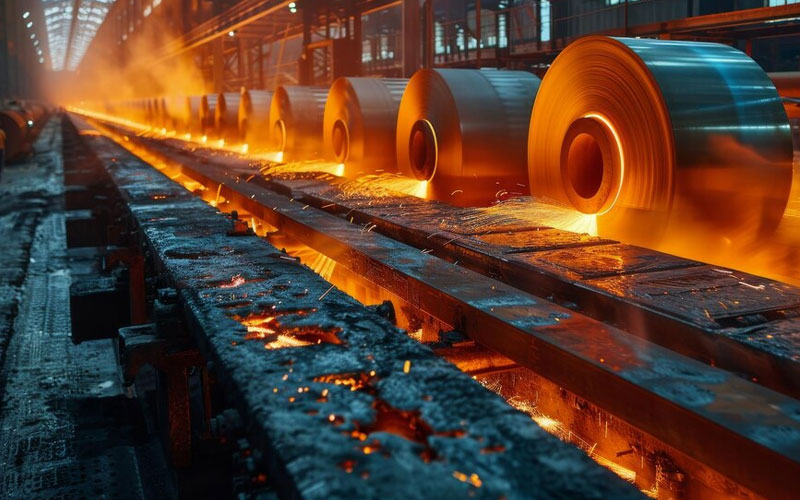The Ministry of Steel is preparing the ‘Green Steel Mission’ with an estimated cost of INR 15000 crore. The Ministry has awarded two pilot projects to produce Direct Reduced Iron (DRI) using 100 percent hydrogen in the vertical shaft. The government has also ensured Steel Import Monitoring System (SIMS) 2.0 revamping for more effective monitoring of imports and has incorporated Quality Control Order (QCO) for the standardization in steel production.
Dec 30, 2024

The government has taken decisive steps to enhance the industry’s environmental sustainability. The Ministry of Steel is preparing the ‘Green Steel Mission’ with an estimated cost of INR 15000 crore for helping the steel industry to reduce carbon emission and progress towards the net zero target.
The Mission includes PLI Scheme for Green Steel, incentives for use of renewable energy and mandates for government agencies to buy green steel.
The Ministry of New and Renewable Energy also spearheaded The National Green Hydrogen Mission that integrates the steel sector into the broader goal of producing and using green hydrogen, contributing to the decarbonisation of steel production.
The steel sector is also a stakeholder in this Mission (The National Green Hydrogen Mission) and has been allocated budgetary support of INR 455 crores for implementation of pilot projects in the iron & steel sector under the Mission up to Financial Year 2029-30.
Under this mission, the Ministry of Steel has awarded two pilot projects to produce Direct Reduced Iron (DRI) using 100 percent hydrogen in the vertical shaft. The first pilot project, initiated on Sept 19, 2024 is to use hydrogen in existing blast furnaces to reduce coal/ coke consumption. The second pilot projects for injection of Green Hydrogen in existing vertical shaft based DRI making units to partially substitute the natural gas are also being explored.
A report on ‘Greening the Steel Sector in India: Roadmap and Action Plan’ on the basis of the recommendations of 14 Task Forces constituted by the Ministry of Steel on various key levers of decarbonisation of the steel sector, was released on Sept 10, 2024.
The Ministry has also released the Taxonomy for Green Steel on Dec 12, 2024 to provide standards for defining and categorizing the low emission steel, facilitating the green transition of the steel industry.
Further, to boost domestic steel manufacturing of ‘Specialty Steel’, a key initiative is the Production-Linked Incentive (PLI) Scheme, aimed at attracting capital investments and reducing imports. Participating companies have committed to an investment of INR 27,106 crore, and estimated a production of 7.90 million tonnes of ‘Specialty Steel’ under the scheme. As of October 2024, companies have already invested INR 17,581 crore in this scheme.
The government as a facilitator has taken the following measures to create a conducive policy environment for increasing production and consumption of steel in the country such as – Implementation of Domestically Manufactured Iron & Steel Products (DMI&SP) policy for promoting ‘Make in India’ steel for Government procurement; and Reduction in the Basic Customs Duty (BCD) on Ferro Nickel, a raw material used in steel production, from 2.5 percent to zero, making it duty free. The government has also made a duty exemption on ferrous scrap up to March 31, 2026 in the Budget 2024.
The government has also ensured Steel Import Monitoring System (SIMS) 2.0 revamping for more effective monitoring of imports to address the concerns of the domestic steel industry. The data submitted by importers on the SIMS portal is compiled and published on the Ministry of Steel website on a fortnightly basis. The revamped SIMS would provide more detailed information regarding Standards and Grades of Steel being imported. It will facilitate in taking appropriate policy measures to address the concerns of the domestic steel industry due to any surge in import of steel.
Furthermore, there is a sufficient reserve of iron ore and non-coking coal in the country but, the coking coal is imported in the country. Steel CPSEs has been procuring coking coal from a diversified group of countries mainly Australia, United States, Russia, Indonesia, Mozambique etc.
Most of the coking coal produced domestically in the country had a very high ash content making it redundant in the manufacture of steel, it has led to the import of 51.20 MMT (Million Metric Tonne) in 2020-21, 57.16 MMT in 2021-22, 56.05 MMT in 2022-23, 58.12 MMT in 2023-24 coking coal and 30.19 MMT in 2024-25 for the period Apr’24 – Sep’24. A major portion of this import is from Australia.
Therefore, the development of a global strategy for India’s steel sector is crucial for enhancing its competitiveness and sustainability in the international market. Fostering partnerships with global players and participating in international forums can help India align its standards with global best practices.
Also Read: INEOS Energy to Acquire CNOOC Energy Holdings’ Oil & Gas Assets in Gulf of Mexico
Accordingly, a Working Group has been formed to formulate India’s Steel Global Outlook Strategy with focus on the four strategic areas for collaboration viz. raw materials, investments, technologies, and steel exports.
Moreover, measures have been taken to formulate standards for the steel consumed in the country and incorporate them in the quality control order (QCO). Standardization involves establishing uniform specifications, testing methods, and manufacturing processes for steel production. This ensures consistency in the quality of steel across different manufacturers. By enforcing QCO, the Government enforces supply of only quality products. By far 151 such steel standards formulated by BIS have been incorporated in the QCO and this exercise is continuing towards the goal of formulating standards for all the steel consumed in the country.










